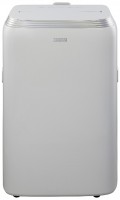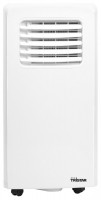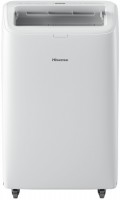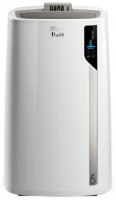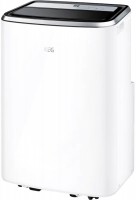Air Conditioners Gree
All Air Conditioners Advanced filters → |
You might be interested in
Articles, reviews, useful tips
All materials
Frequently asked questions about air conditioners
Everything you should know about air conditioner before buying it

Deciphering the labeling of Haier air conditioners
Features of labeling, decoding of designations and general standards of Haier air conditioners

The main rules for choosing a place for an air conditioner in an apartment
Where to install the air conditioner so that it is as efficient as possible, does not impair the lifestyle of residents and interior design

How to choose an air conditioner
The main criteria to consider when choosing an air conditioner

Deciphering the labeling of Daikin air conditioners
As part of this article, we will focus on deciphering the "names" of Daikin air conditioners

Choosing a split system for your home: elite, "good" China or economy class?
A good Chinese air conditioner is a good alternative to an expensive split system of a Japanese premium brand
Air Conditioners: specifications, types
Show all
Type
General type of air conditioner.
Nowadays, on the market you can mainly find split systems, multi split systems, portable devices. More rare options are window models and monoblocks. Here is a more detailed description of each of these options:
— Split system. The most popular type of modern air conditioner. Such models consist of two units — indoor and outdoor. The outdoor uni...t is responsible for heat exchange with the environment — it is through it that excess heat is discharged (or vice versa, external heat is taken into the room, when working for heating). The indoor units are installed in the room, the conditioned air comes from it. Both units are connected by pipes through which the coolant circulates. Air conditioners of this type are convenient, in particular, because the indoor unit can be installed almost anywhere in the room; and in some models, the indoor units have an unusual design (see below), which allows such devices to fit even into non-standard interiors. Also note that split systems can have almost any performance, among them there are models of both household and industrial levels, and the installation of such air conditioners is relatively simple. All this led to their popularity.
— Multi split system. A kind of split system (see above), in which there are several indoor ones for one outdoor unit. This arrangement allows using one air conditioner to organize climate control in several rooms at once, while the installation of such a system is easier, and the cost is cheaper than using separate split systems.
— Portable. Air conditioners made as a single unit, designed for the possibility of frequent movement from place to place; in some models, wheels are even provided for this. For heat exchange with the external environment, such devices use air ducts that lead out of a window, doorway, ventilation shaft, etc. A mobile air conditioner can be a real salvation where it is not possible to install a stationary device: it does not require complex installation work, just figure out where to bring the duct pipe. In addition, such a unit can be useful in a situation where you need to cool several rooms in turn, and it is difficult or impossible to install a stationary air conditioner for this purpose.
— Window. Air conditioners made as a single unit, installed directly in the window opening — so that one side of the device is indoors, the other is outdoors. It is one of the first types of air conditioners, but, nowadays, it is considered obsolete and rare — mainly due to the complexity of installation and a very limited choice of installation locations. In addition, such an assembly inevitably covers part of the window, which in some cases is also a serious drawback.
— Monoblock. Stationary air conditioners in the form of a single unit with wall installation. Such a unit is located inside the room, on the wall facing the outside, and heat exchange is provided by air ducts passed through the wall, through which the outside air enters the heat exchanger and exits it. Such a design allows you to do without outdoor units, which is very convenient in some situations — for example, if an air conditioner is needed for a historical building or house in a strictly defined design that does not allow unnecessary "decorations" on the facade. On the other hand, monoblocks are expensive, and the possibilities for their installation are very limited.
Nowadays, on the market you can mainly find split systems, multi split systems, portable devices. More rare options are window models and monoblocks. Here is a more detailed description of each of these options:
— Split system. The most popular type of modern air conditioner. Such models consist of two units — indoor and outdoor. The outdoor uni...t is responsible for heat exchange with the environment — it is through it that excess heat is discharged (or vice versa, external heat is taken into the room, when working for heating). The indoor units are installed in the room, the conditioned air comes from it. Both units are connected by pipes through which the coolant circulates. Air conditioners of this type are convenient, in particular, because the indoor unit can be installed almost anywhere in the room; and in some models, the indoor units have an unusual design (see below), which allows such devices to fit even into non-standard interiors. Also note that split systems can have almost any performance, among them there are models of both household and industrial levels, and the installation of such air conditioners is relatively simple. All this led to their popularity.
— Multi split system. A kind of split system (see above), in which there are several indoor ones for one outdoor unit. This arrangement allows using one air conditioner to organize climate control in several rooms at once, while the installation of such a system is easier, and the cost is cheaper than using separate split systems.
— Portable. Air conditioners made as a single unit, designed for the possibility of frequent movement from place to place; in some models, wheels are even provided for this. For heat exchange with the external environment, such devices use air ducts that lead out of a window, doorway, ventilation shaft, etc. A mobile air conditioner can be a real salvation where it is not possible to install a stationary device: it does not require complex installation work, just figure out where to bring the duct pipe. In addition, such a unit can be useful in a situation where you need to cool several rooms in turn, and it is difficult or impossible to install a stationary air conditioner for this purpose.
— Window. Air conditioners made as a single unit, installed directly in the window opening — so that one side of the device is indoors, the other is outdoors. It is one of the first types of air conditioners, but, nowadays, it is considered obsolete and rare — mainly due to the complexity of installation and a very limited choice of installation locations. In addition, such an assembly inevitably covers part of the window, which in some cases is also a serious drawback.
— Monoblock. Stationary air conditioners in the form of a single unit with wall installation. Such a unit is located inside the room, on the wall facing the outside, and heat exchange is provided by air ducts passed through the wall, through which the outside air enters the heat exchanger and exits it. Such a design allows you to do without outdoor units, which is very convenient in some situations — for example, if an air conditioner is needed for a historical building or house in a strictly defined design that does not allow unnecessary "decorations" on the facade. On the other hand, monoblocks are expensive, and the possibilities for their installation are very limited.
Installation
The type of installation is specified for the indoor unit of the air conditioner.
The classic most popular mounting option these days is the wall mount. It is these air conditioners that are most often used for living rooms and small office premises, although there are also heavy powerful equipment that can serve a large area. Units with the possibility of floor or ceiling installation have similar specifics, but they ar...e not so common. And purely floor air conditioners are even rarer, and their power is generally low; heavy and powerful floor units are classified as a separate category - column.
Ceiling (cassette) units are excellent for servicing rooms with partitions, including quite extensive ones. You should pay attention to ducted models if you need to serve several rooms at once with a common duct system. The portable type of installation means that we have a mobile air conditioner (see "Type"). But units with window installation, which were quite popular at one time, are now considered obsolete and are rarely used (although they can also come in handy in certain situations).
Here is a more detailed description of each mounting type:
- Wall mounted. Mounting on the wall — usually in the upper part, under the ceiling. In most rooms, this type of placement causes the least inconvenience and gives the most freedom in choosing the installation location. So, the space on the walls under the ceiling is usually not occupied by anything (or almost nothing), and the installation work is limited to the preparation of fixtures for hanging and holes for hoses connecting the indoor unit to the outdoor one. It is the reason for the popularity of wall-mounted air conditioners in our time.
- Floor. Relatively low-power air conditioners are designed for installation on the floor, usually with a wall mount (heavy floor-standing units are classified into a separate category — column, see below). In itself, such installation is somewhat simpler than wall mounting, in addition, the airflow from the floor unit is usually directed upwards, which minimizes the likelihood of drafts. On the other hand, not every room has enough space on the floor against the wall — especially since there must be some space in front of the air conditioner for efficient air intake. In addition, such placement increases the likelihood of accidentally touching the unit. Therefore, purely floor models are relatively rare, combined floor-ceiling air conditioners are more popular (see below).
- Floor/ceiling. It is a wall model, complemented by the possibility of installation on the floor against the wall. Both methods of installation are described in more detail above; it is technically easy to provide two methods at once in one air conditioner, and such versatility makes the devices more attractive in the eyes of buyers. Therefore, such combined units in our time, although they are inferior in popularity to wall-mounted ones, are noticeably superior to purely floor ones.
— Cassette (ceiling). Ceiling mount, usually between fixed and suspended ceilings. Most air conditioners of this type are designed to service fairly large rooms, including those with partitions. Such units are square and direct the airflow in 4 directions at once; thus, the optimal place to install such an air conditioner is in the centre of the room. However, there are also low-power ceiling models designed for small rooms; for such units, the airflow is directed in one direction, and they are mounted near the wall itself. In any case, the airflow from the cassette air conditioner is directed almost horizontally. It avoids drafts, and uniform cooling of the room is ensured by the fact that the heavier cold air from the air conditioner settles down, mixing with warm air.
- Ducted. The name of such air conditioners is because the air from them enters the room (rooms) not directly from the indoor unit, but through ventilation ducts. The unit itself, as a rule, is made completely hidden in a wall or behind a false ceiling. It is very convenient in cases where cold air needs to be directed to several places at once, which are significantly remote from each other — for example, to several office premises at once. An alternative option for such cases is multi-split systems (see "Type"). However, a ducted air conditioner can be cheaper and easier to install, especially if the air outlets are already connected by a duct system, or if you need to cool a large area such as an entire building with several floors and a large number of individual rooms. The disadvantage of this option is that the intensity of cooling/heating will be the same for all serviced premises (whereas the multi-split allows you to adjust it individually for each indoor unit). In addition, in the absence of air ducts, their organization can be a rather time-consuming and expensive task.
- Column. Heavy-duty floor-mounted air conditioners. From the classic floor models (see above), in addition to high power, they differ in layout - in this case, it is vertical, like a column (hence the name). In addition, such units usually do not require wall mounting (although many models allow it if necessary). A key feature of column air conditioners is the ability to create a powerful airflow that can quickly cool or warm up a large area. On the other hand, such a flow of air can create serious discomfort for a person nearby. Therefore, the best way to use columned units is to serve large areas where, for one reason or another, it is impossible to use other types of air conditioners (such as cassette). An air conditioner with this type of installation may be the best choice for a shop floor, restaurant, large hotel lobby, and even for a large room in a private house or apartment.
- Portable. In addition to connecting to the mains, you will also need an outlet for the air hose.
— Window. Air conditioners mounted in an opening in a window frame or wall. The installation of such units is a rather complicated and troublesome business, and the choice of installation sites for them is very limited. In many ways, this is why window air conditioners are not popular anymore.
The classic most popular mounting option these days is the wall mount. It is these air conditioners that are most often used for living rooms and small office premises, although there are also heavy powerful equipment that can serve a large area. Units with the possibility of floor or ceiling installation have similar specifics, but they ar...e not so common. And purely floor air conditioners are even rarer, and their power is generally low; heavy and powerful floor units are classified as a separate category - column.
Ceiling (cassette) units are excellent for servicing rooms with partitions, including quite extensive ones. You should pay attention to ducted models if you need to serve several rooms at once with a common duct system. The portable type of installation means that we have a mobile air conditioner (see "Type"). But units with window installation, which were quite popular at one time, are now considered obsolete and are rarely used (although they can also come in handy in certain situations).
Here is a more detailed description of each mounting type:
- Wall mounted. Mounting on the wall — usually in the upper part, under the ceiling. In most rooms, this type of placement causes the least inconvenience and gives the most freedom in choosing the installation location. So, the space on the walls under the ceiling is usually not occupied by anything (or almost nothing), and the installation work is limited to the preparation of fixtures for hanging and holes for hoses connecting the indoor unit to the outdoor one. It is the reason for the popularity of wall-mounted air conditioners in our time.
- Floor. Relatively low-power air conditioners are designed for installation on the floor, usually with a wall mount (heavy floor-standing units are classified into a separate category — column, see below). In itself, such installation is somewhat simpler than wall mounting, in addition, the airflow from the floor unit is usually directed upwards, which minimizes the likelihood of drafts. On the other hand, not every room has enough space on the floor against the wall — especially since there must be some space in front of the air conditioner for efficient air intake. In addition, such placement increases the likelihood of accidentally touching the unit. Therefore, purely floor models are relatively rare, combined floor-ceiling air conditioners are more popular (see below).
- Floor/ceiling. It is a wall model, complemented by the possibility of installation on the floor against the wall. Both methods of installation are described in more detail above; it is technically easy to provide two methods at once in one air conditioner, and such versatility makes the devices more attractive in the eyes of buyers. Therefore, such combined units in our time, although they are inferior in popularity to wall-mounted ones, are noticeably superior to purely floor ones.
— Cassette (ceiling). Ceiling mount, usually between fixed and suspended ceilings. Most air conditioners of this type are designed to service fairly large rooms, including those with partitions. Such units are square and direct the airflow in 4 directions at once; thus, the optimal place to install such an air conditioner is in the centre of the room. However, there are also low-power ceiling models designed for small rooms; for such units, the airflow is directed in one direction, and they are mounted near the wall itself. In any case, the airflow from the cassette air conditioner is directed almost horizontally. It avoids drafts, and uniform cooling of the room is ensured by the fact that the heavier cold air from the air conditioner settles down, mixing with warm air.
- Ducted. The name of such air conditioners is because the air from them enters the room (rooms) not directly from the indoor unit, but through ventilation ducts. The unit itself, as a rule, is made completely hidden in a wall or behind a false ceiling. It is very convenient in cases where cold air needs to be directed to several places at once, which are significantly remote from each other — for example, to several office premises at once. An alternative option for such cases is multi-split systems (see "Type"). However, a ducted air conditioner can be cheaper and easier to install, especially if the air outlets are already connected by a duct system, or if you need to cool a large area such as an entire building with several floors and a large number of individual rooms. The disadvantage of this option is that the intensity of cooling/heating will be the same for all serviced premises (whereas the multi-split allows you to adjust it individually for each indoor unit). In addition, in the absence of air ducts, their organization can be a rather time-consuming and expensive task.
- Column. Heavy-duty floor-mounted air conditioners. From the classic floor models (see above), in addition to high power, they differ in layout - in this case, it is vertical, like a column (hence the name). In addition, such units usually do not require wall mounting (although many models allow it if necessary). A key feature of column air conditioners is the ability to create a powerful airflow that can quickly cool or warm up a large area. On the other hand, such a flow of air can create serious discomfort for a person nearby. Therefore, the best way to use columned units is to serve large areas where, for one reason or another, it is impossible to use other types of air conditioners (such as cassette). An air conditioner with this type of installation may be the best choice for a shop floor, restaurant, large hotel lobby, and even for a large room in a private house or apartment.
- Portable. In addition to connecting to the mains, you will also need an outlet for the air hose.
— Window. Air conditioners mounted in an opening in a window frame or wall. The installation of such units is a rather complicated and troublesome business, and the choice of installation sites for them is very limited. In many ways, this is why window air conditioners are not popular anymore.
Unusual design
Unusual design of the indoor unit of the air conditioner.
An unusual design in this case is any design that differs markedly from the traditional “white rectangular case” option. Such air conditioners can have rounded outlines or non-standard proportions of the case, be made in different colours (in particular, red, black and dark grey are especially popular), and also be equipped with additional decorative elements — up to the frame where you can ins...ert a picture as you wish. Thus, devices with this feature are not just household appliances, but also an element of decor; an unusual air conditioner can noticeably enliven even a completely standard room, and even for originally designed interiors, such equipment is simply irreplaceable.
An unusual design in this case is any design that differs markedly from the traditional “white rectangular case” option. Such air conditioners can have rounded outlines or non-standard proportions of the case, be made in different colours (in particular, red, black and dark grey are especially popular), and also be equipped with additional decorative elements — up to the frame where you can ins...ert a picture as you wish. Thus, devices with this feature are not just household appliances, but also an element of decor; an unusual air conditioner can noticeably enliven even a completely standard room, and even for originally designed interiors, such equipment is simply irreplaceable.
Nominal capacity BTU
The British Thermal Unit (BTU) is used to indicate the rated capacity of air conditioners in cooling mode. The parameter is indicated mainly for split and multi split systems with wall installation. Capacity is indicated in BTU per hour, while 1 BTU/h is equal to about 0.293 watts. The rated capacity of an air conditioner is often a multiple of 1000 BTU. The indicator determines how many thousand BTU/h the air conditioning equipment provides. For example, the marking "9 BTU" here means a unit fo...r 9000 BTU/h or about 2600 watts of effective capacity.
The practical meaning of the capacity is that by BTU you can easily determine the recommended area of a standard room in square meters: just multiply the figure indicated in the characteristics by 3. So, for 9 BTU it will correspond to 9*3=27 m². Note that there is no strict relationship between BTU and watts in this list: for example, air conditioners with an effective capacity of 2360 to 2900 W fall into the same category of 9 BTU. In practice, even such an approximate ratio is enough to understand which air conditioner should be considered for cooling certain area.
The practical meaning of the capacity is that by BTU you can easily determine the recommended area of a standard room in square meters: just multiply the figure indicated in the characteristics by 3. So, for 9 BTU it will correspond to 9*3=27 m². Note that there is no strict relationship between BTU and watts in this list: for example, air conditioners with an effective capacity of 2360 to 2900 W fall into the same category of 9 BTU. In practice, even such an approximate ratio is enough to understand which air conditioner should be considered for cooling certain area.
In box
A set of components included in the delivery of the air conditioner.
This parameter is indicated only for split and multi split systems (see "Type") — other types of air conditioners are made as single units, and there is simply no need to specify the complete set for them. Split system can be supplied both in a complete set, and in separate units (both indoor and outdoor). Among tradition...al split systems, the first option is the most popular: it is most convenient to buy such a solution as a ready-made kit, and the purchase of a separate unit is required if one of the original units breaks down. But the components of multi split air conditioners, on the contrary, are most often sold separately — this makes it easy to assemble such a system for a specific situation by separately purchasing an outdoor unit and the required number of indoor ones.
This parameter is indicated only for split and multi split systems (see "Type") — other types of air conditioners are made as single units, and there is simply no need to specify the complete set for them. Split system can be supplied both in a complete set, and in separate units (both indoor and outdoor). Among tradition...al split systems, the first option is the most popular: it is most convenient to buy such a solution as a ready-made kit, and the purchase of a separate unit is required if one of the original units breaks down. But the components of multi split air conditioners, on the contrary, are most often sold separately — this makes it easy to assemble such a system for a specific situation by separately purchasing an outdoor unit and the required number of indoor ones.
Number of indoor units
The number of indoor units supplied in the kit.
Split and multi split systems are divided into outdoor and indoor units (see "Type"). And the number of indoor units in the kit depends on how many rooms the air conditioner can serve out of the box. However, this parameter is more of a reference than practically significant. So, in a complete set (see "In box") split systems are supplied with one indoor unit. And in the multi split system, a complete set is rare and usually includes tw...o such units; it is assumed that for the organization of a more extensive system, it is more convenient to purchase an outdoor unit and separately purchase the required number of indoor ones for it. Separate indoor units of multi split systems are also sold one by one.
Split and multi split systems are divided into outdoor and indoor units (see "Type"). And the number of indoor units in the kit depends on how many rooms the air conditioner can serve out of the box. However, this parameter is more of a reference than practically significant. So, in a complete set (see "In box") split systems are supplied with one indoor unit. And in the multi split system, a complete set is rare and usually includes tw...o such units; it is assumed that for the organization of a more extensive system, it is more convenient to purchase an outdoor unit and separately purchase the required number of indoor ones for it. Separate indoor units of multi split systems are also sold one by one.



